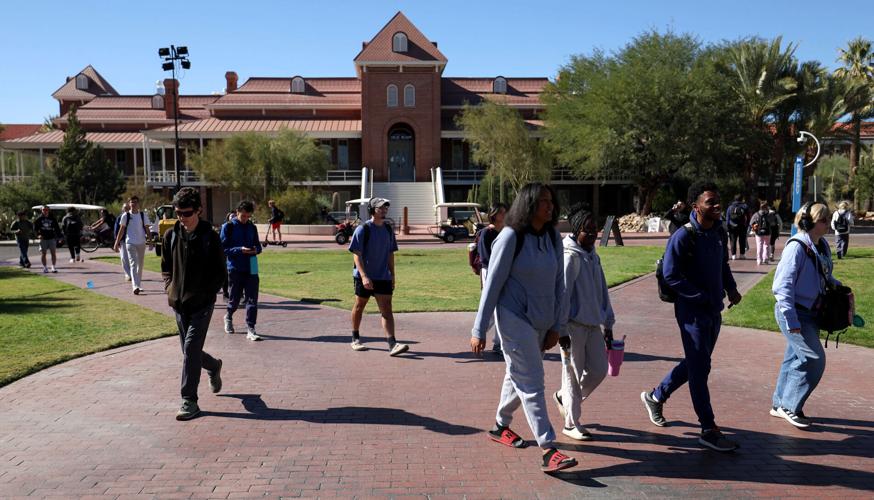The University of Arizona’s administrative payroll went up by more than $1.5 million between fiscal years 2024 and 2025 — despite the elimination of 13 vice president positions.
The increase took the payroll for administrators to $22.1 million, according to the UA’s new First Quarter of Fiscal Year 2025 report, which delves into employee headcounts and payroll spending. There are 285 administrators.
“What we saw was those vice presidents we talked about went away, but we hired other positions that replaced a lot of those,” said UA’s Chief Financial Officer and Chief Operating Officer John Arnold in an interview Tuesday with the Arizona Daily Star. “Specifically, we started a new college this year, which is the College of Health Sciences.”
“There were seven administrators associated specifically with that college,” he said. The Arizona Board of Regents approved the new college as part of a push at all three state universities to help address a shortage of health-care professionals.
The seven positions were filled internally while former President Robert C. Robbins was still in charge, said UA spokesperson Mitch Zak. He confirmed they were hired after the university’s “hiring freeze,” which was lifted on June 30.

Students walk around the University of Arizona mall.
“The new college has been in the works for years, and it was really born out of the Board of Regents’ desire to expand health care for Arizonans,” said Arnold. “The university responded to that by developing these additional offerings that are in high, high demand and there’s high, high needs for those offerings in the state.”
Despite the higher administrative payroll, cutting the 13 vice president positions did save costs for the university, Zak said. The VP contracts did not involve buyouts when the positions were cut, and the contracts concluded when their work was done, he said.
Administrative payroll spending for FY 2025 breaks down to $17.2 million for colleges; about $1 million for the provost’s office — which includes academic affairs, student life, diversity and inclusion, enrollment management, Arizona online, outreach, distance and continuing education, Arizona international and undergraduate education, and all academic and student support priorities; and $3.8 million for central administration.
Faculty positions cut
In the new report, the UA also revealed that 42 full-time faculty positions were cut, taking the full-time faculty count down to 2,594 from 2,636, as the university worked to reduce its deficit from $177 million to $63 million in fiscal year 2024.
However, Arnold told the Star the number of full-time faculty has already been brought up from 2,594 to 2,607 and part-time faculty increased from 517 to 554.
“The (hiring) freeze is off, we’re processing new hires everyday, our employee count continues to go up,” said Arnold. “… Hiring continues to go, but that’s part of the natural cycle the university is on. We hit our low-point employment probably mid-July, and then it starts to climb, and it continues to climb until probably February-March, and then it starts to decline as we wind down towards the end of the year.”
He said fiscal year 2025’s “employee numbers have returned to levels comparable to those seen two years ago in the first quarter of fiscal year 2023.” Arnold called that “pretty powerful.”

The University of Arizona campus.
The number of full-time service professionals increased from 35 to 36, and the ranks of postdoctoral scholars remained stagnant at 129.
Every other section saw a reduction between the first quarters of FY 2024 and 2025. The number of classified staff went from 433 to 348 (-85), professionals from 342 to 291 (-51), and academic professionals decreased from 210 to 194 (-16).
The spending report excludes UA Global Campus employees.
In full-time positions, faculty payroll took the biggest drop, going down from $75.5 million to $71.6 million. Classified staff payroll took the second-highest hit, dropping from $5.47 million to $4.47 million. Academic professionals’ payroll decreased from $5.4 million to $4.8 million, and professional employees’ payroll dropped to $1.7 million from $2.2 million.
In deciding where to cut budgets university-wide, “We relied heavily on the deans,” said Arnold. “I was relatively new to the university, so the provost (Ron Marx) and I met with every single dean last spring, starting February, March and April, went through the budgets for their departments, asked them to bring forward ideas on how they could reduce their budgets, and we gave some guidance. We accepted their ideas and then asked them to implement the budget they were assigned. And so yeah, those decisions on how to implement were really at the college level.”
In payrolls for part-time employees, assistant/associate employees’ payroll was cut from $7.1 million to $5.7 million; part-time student workers’ costs were reduced from $3.6 million to $3.3 million; and part-time faculty costs went down from $2.7 million to $2.6 million.
Arnold said it isn’t clear if the number of graduate associates/assistants will rise to what it was before the deficit.
“Graduate assistants depends on workload and then dollars,” he said. “We certainly want to employ and support graduate assistants, same with student workers. And, you know, I’d very much like to see our employment of student workers come back up as we stabilize and move forward.”





